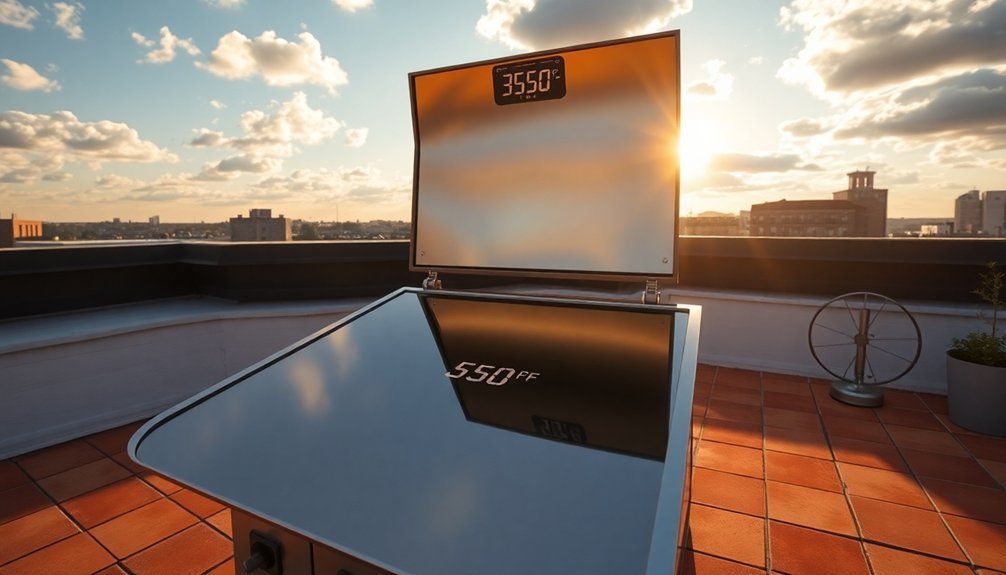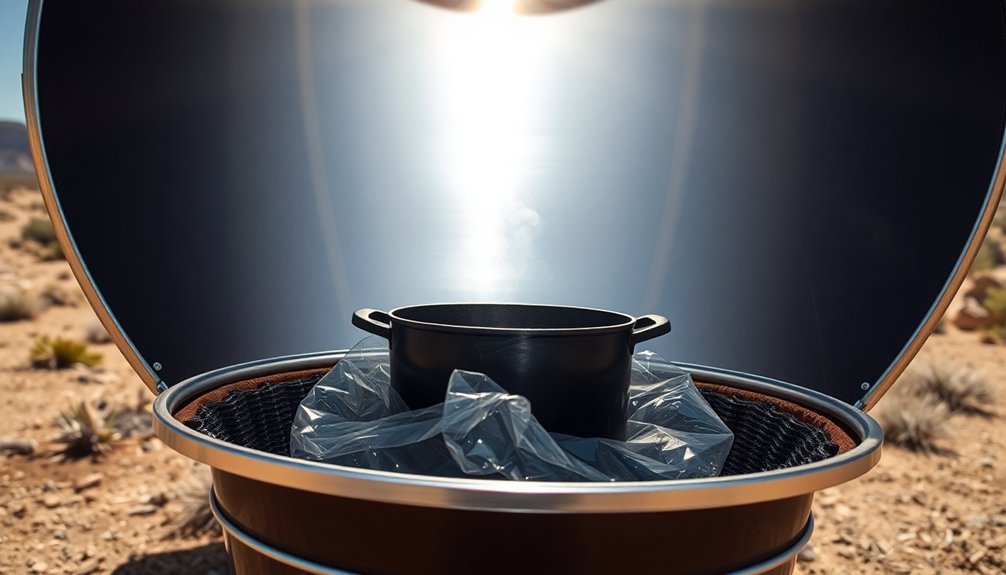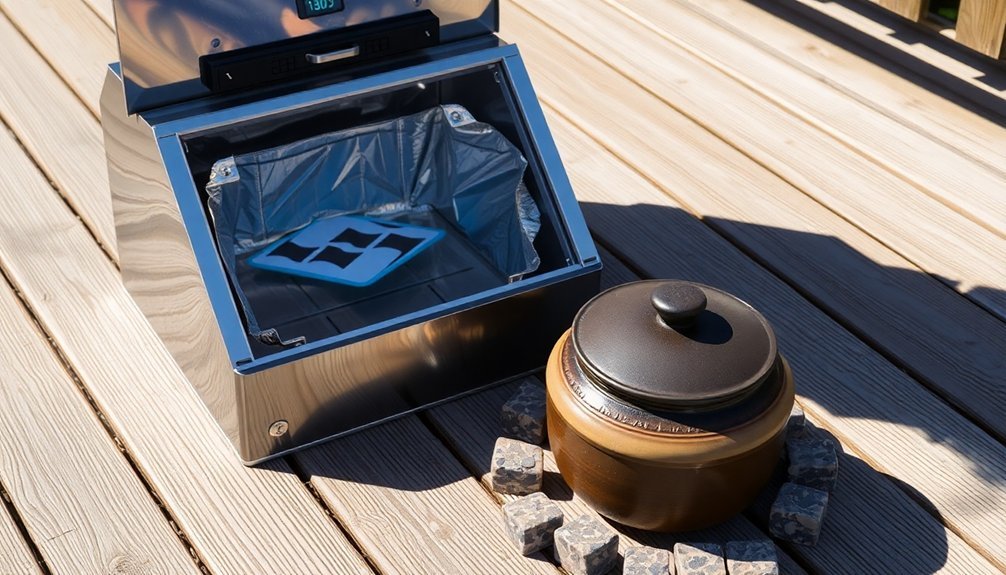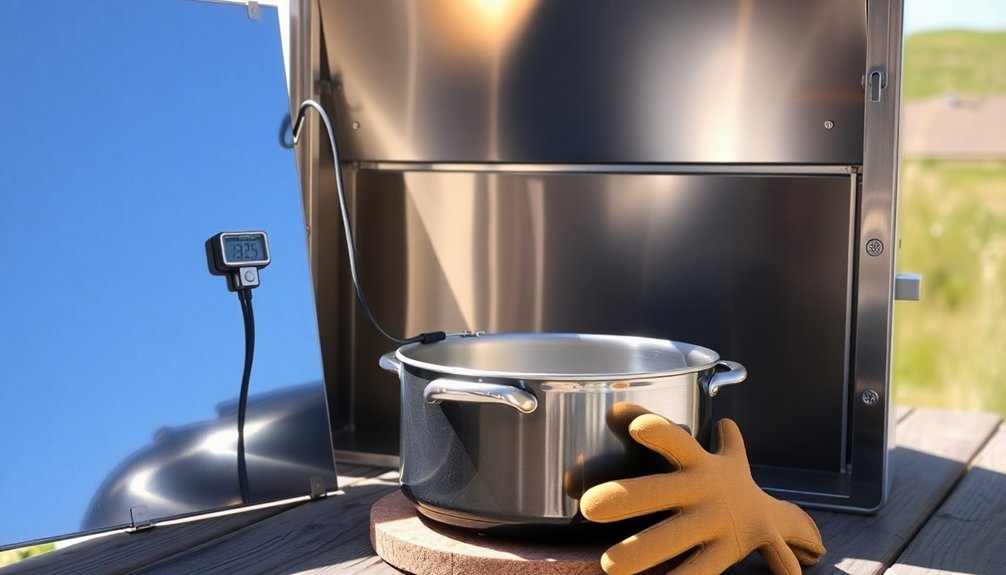Control your solar cooker's temperature effectively with these essential tips. Position your cooker between 11 AM and 3 PM for maximum sunlight exposure, rotating it every 20-30 minutes to follow the sun's path. Create robust insulation by layering black construction paper, aluminum foil, and natural materials like wool or straw between the inner and outer boxes. Use dark cookware with tight-fitting lids to trap heat and prevent steam loss. Monitor food temperatures with a digital probe thermometer, keeping them above 125°F for safety. Aim for days with a UV index of 7 or higher to guarantee the best cooking conditions. These fundamentals will set you up for more advanced solar cooking techniques.
Strategic Oven Placement

When it comes to maximizing your solar cooker's efficiency, proper placement is essential for maintaining consistent temperatures. Position your cooker between 11 AM and 3 PM when sunlight is strongest, and select a dry, level surface away from any shade.
You'll need to rotate the cooker every 20-30 minutes to follow the sun's path. Orient the shorter front panel eastward for lunch or westward for dinner preparations. During winter months, start cooking earlier around 10 AM to achieve better results. Adjust your reflector flap's angle to match your latitude, ensuring peak sunlight concentration.
For stability, especially on windy days, place large stones around the base or position the cooker near a building that can act as a windbreak. Create additional protection using recycled glass panels or natural barriers, and always check that the cooker's shadow falls directly behind it for ideal alignment.
Insulation Layer Setup
Three key layers of insulation form the foundation of an effective solar cooker.
You'll need to start with a base layer of black construction paper at the bottom to absorb heat effectively.
Next, fill the space between your inner and outer boxes with tightly packed insulation materials like fiberglass, rockwool, or crumpled newspapers.
For the final layer, line all sides of your cooking cavity (except the glazed top) with aluminum foil to reflect heat inward.
You'll want to seal all seams with tape and make certain there aren't any gaps where heat could escape.
If you're looking for extra efficiency, consider using double glazing on top and adding natural insulators like wool, straw, or down feathers between the boxes. Drawing from natural building principles, these sustainable materials provide excellent thermal mass while minimizing environmental impact.
Remember to keep your insulation materials dry and well-packed for maximum heat retention.
Heat Loss Prevention Methods

To maintain consistent cooking temperatures in your solar cooker, implementing multiple heat loss prevention strategies is crucial. You'll need to focus on sealing heat effectively while maximizing solar energy absorption. Use dark-colored cookware with tight-fitting lids and guarantee your transparent cover creates an insulating air layer. Position reflective panels to redirect sunlight toward your cooking vessel. For maximum efficiency, proper insulation and covers ensure optimal heat retention. Don't forget to adjust your cooker's position every 1-2 hours to track the sun's movement, guaranteeing ideal temperature maintenance throughout your cooking session.
| Prevention Method | Primary Function | Key Benefit |
|---|---|---|
| Dark Surfaces | Heat Absorption | Maximizes energy capture |
| Reflective Panels | Light Direction | Increases heat concentration |
| Glass/Plastic Cover | Heat Trapping | Creates greenhouse effect |
| Tight-Fitting Lids | Vapor Retention | Prevents steam escape |
| Regular Tracking | Sun Alignment | Maintains temperature |
Temperature Monitoring Best Practices
Building on proper heat retention, accurate temperature monitoring stands at the heart of successful solar cooking.
You'll need a reliable digital probe thermometer that's calibrated regularly and can read temperatures up to 100°C or higher.
Position your thermometer through sealed holes in pot lids to shield it from direct sunlight while getting accurate readings.
You'll want to track both ambient and food temperatures, especially during hot and cold starts. For precise measurements, consider using Type-K thermocouples or digital data loggers.
Keep food temperatures above 125°F to prevent bacterial growth, and aim for internal temperatures between 180°F and 250°F for safe consumption. For maximum efficiency and safety, cook foods during the peak sun hours of 11 AM to 3 PM.
When reheating leftovers, verify they reach at least 165°F.
Remember to record temperatures in both Fahrenheit and Celsius for complete documentation of your cooking process.
Weather Impact Management

While solar cooking offers an eco-friendly cooking method, its success heavily depends on weather conditions and seasonal variations.
You'll need to monitor the UV Index forecast, aiming for days when it's 7 or higher for ideal results. Plan your cooking between 10:00 a.m. and 2:00 p.m. when the sun's intensity peaks.
You can manage weather impacts by having backup cooking methods ready for cloudy, rainy, or snowy days. During winter months, you'll need to adjust your cooker more frequently due to the sun's lower position.
For partly cloudy days, focus on slow-cooking foods like beans and potatoes. Consider using thermal mass objects like bricks to store heat when sunlight diminishes.
Always start cooking early enough to guarantee sufficient daylight for completing your meal.
Frequently Asked Questions
Can Frozen Foods Be Safely Thawed in a Solar Oven?
You shouldn't thaw frozen foods in a solar oven. Instead, you'll want to thaw them safely in your refrigerator, cold water, or microwave first. Once thawed, you can then cook them immediately.
How Do Different Colored Cooking Vessels Affect Cooking Temperature and Time?
You'll find dark-colored vessels cook food faster because they absorb more sunlight and heat. Black pots heat up quickest, while lighter colors reflect energy away. This directly impacts your cooking time and temperature control.
Does Altitude Affect Solar Oven Cooking Temperatures?
Yes, your solar oven will reach higher temperatures at greater altitudes. You'll experience more intense solar radiation due to thinner atmosphere, which means less interference and more direct sunlight reaching your cooking vessel.
What's the Maximum Internal Temperature a Well-Designed Solar Oven Can Achieve?
You'll find that a well-designed solar oven can reach up to 464°F (240°C), particularly in commercial models like the SunChef Pro. Most quality solar ovens typically achieve temperatures between 150-400°F (66-204°C).
Can Solar Ovens Be Effectively Used for Baking Bread and Pastries?
Yes, you can effectively bake bread and pastries in solar ovens that reach 210-300°C. You'll achieve best results during peak sunlight hours, and you can expect baking times of 20-25 minutes for smaller items.
In Summary
By following these five key strategies for temperature control, you'll get consistent results from your solar cooking. Whether you're adjusting the oven's position, layering insulation, preventing heat escape, monitoring temps, or working with weather patterns, you've got the tools to maintain ideal cooking temperatures. Put these methods into practice, and you'll transform your sun-powered cooking from unpredictable to reliable every time.





Leave a Reply